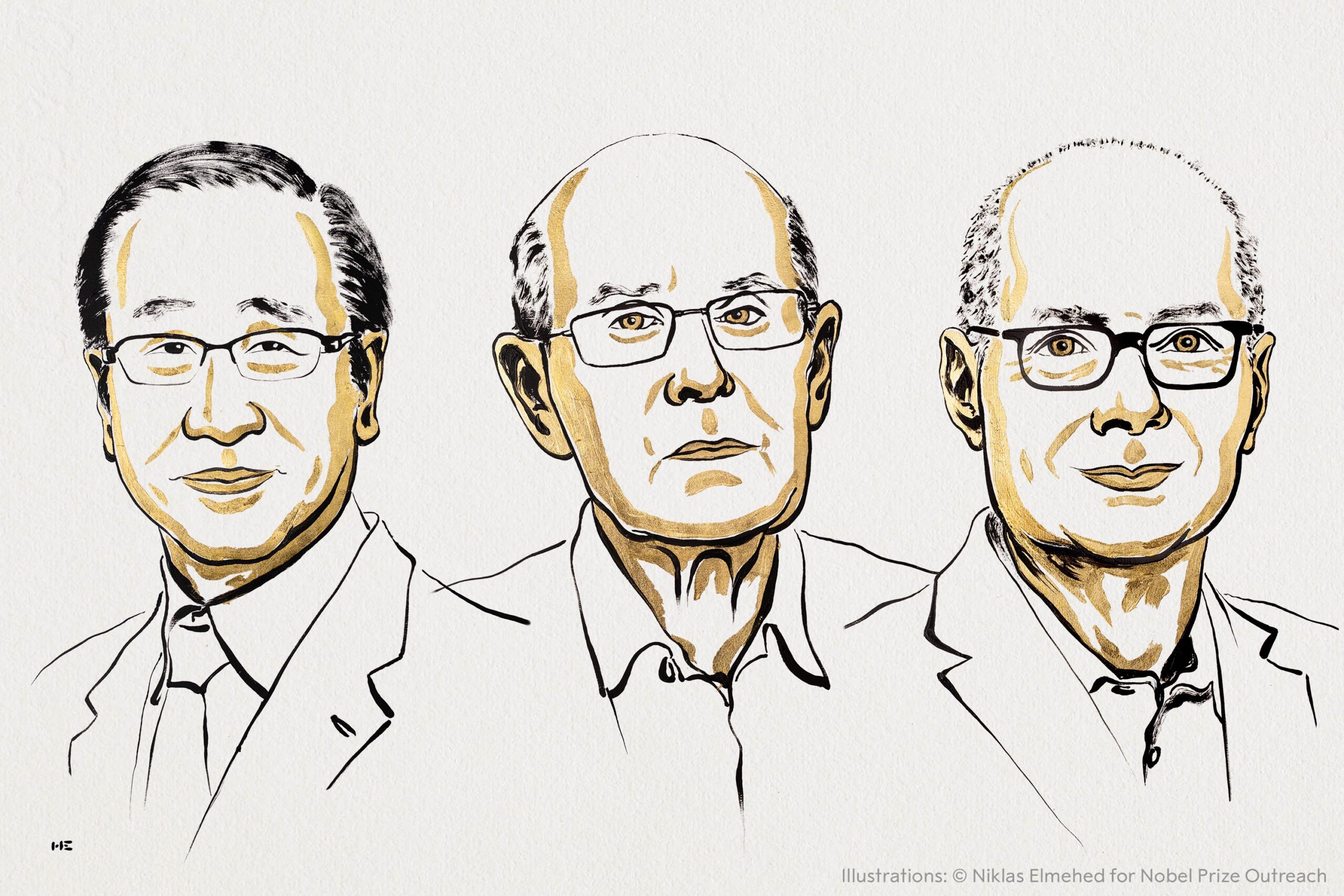2025 Nobel Prize in Chemistry recognizes development of new molecular architecture
Susumu Kitagawa, Richard Robson and Omar Yaghi jointly awarded for their work developing new porous materials with wide-ranging applications
Madeline Shaw • October 8, 2025

Susumu Kitagawa, Richard Robson and Omar M. Yaghi, winners of the 2025 Nobel Prize in Chemistry [Credit: Niklas Elmehed | © Nobel Prize Outreach]
The 2025 Nobel Prize in Chemistry went to Susumu Kitagawa from Kyoto University, Richard Robson from the University of Melbourne, and Omar M. Yaghi from the University of California, Berkeley. They were recognized for their work creating a new form of molecular architecture known as metal-organic frameworks (MOFs).
Like the beams and nails framing the rooms of a house, MOFs are composed of long organic molecules connected by metal ion cornerstones to form crystals with large cavities. These holes can be designed to capture, store, transform and release specific substances, such as water or carbon dioxide, offering wide-ranging applications for health, industry and the environment.
“A small amount of [MOF] material can be almost like Hermoine’s handbag in Harry Potter. It can store huge amounts of gas in a tiny volume,” said Heiner Linke, the chair of the Nobel Committee for Chemistry during the announcement press conference. “Imagine that the tools of chemistry could be used to create entirely new materials with unheard of properties. … This year’s laureates have achieved just that.”
MOF applications include capturing drinking water from air, separating carbon dioxide from manufacturing emissions and mining valuable rare earth elements from runoff. Researchers are also exploring MOFs as a way to deliver drugs to the body, remove and break down oil spills and extract PFAS “forever chemicals” from wastewater.
“To build such ordered structures was a very, very difficult challenge for many, many years,” Olof Ranstrom, a member of the Nobel Committee for Chemistry and an expert on MOFs, said at the press conference. “Although we knew about structures that looked like this, how to actually predictably be able to make them was very elusive.”
In 1989, Robson made a breakthrough when he combined positively charged copper ions with a four-armed molecule, forming a pyramid structure similar to diamonds that was filled with holes.
In experiments, he demonstrated these crystals could be adapted for specific materials and could catalyze chemical reactions. Even though he immediately recognized the molecular structure’s potential, his designs were unstable and fell apart easily.
The separate contributions of Kitagawa and Yaghi from 1992 to 2003 strengthened and expanded on Robson’s discovery, the press release explains.
Kitagawa showed that gas absorption — one of the most important applications of porous materials — was possible in MOFs by designing a complex framework of channels stable enough to absorb and release methane, oxygen and nitrogen. He also hypothesized that MOFs have the flexibility to shape-shift in different conditions, making them soft and pliable.
During the same period, Yaghi created a design, known as MOF-5, with “astonishing” stability and surface area that was “an eye-opener for the entire field,” Ranstrom said during the press conference. By combining metal ions with organic linkages in a grid, the material could withstand temperatures up to 300 degrees Celsius. Just a few grams — the size of a sugar cube — contains about the same surface area as a soccer field.
Yaghi later demonstrated that MOFs could be altered by changing the size and properties of the organic linkages without disrupting the overall framework, opening up the possibility of large families of MOFs with the same structure but different capabilities. This gave MOFs new and desirable properties, according to the press release.
In the years since the laureates first demonstrated MOF’s potential, chemists have already designed tens of thousands of different types, “facilitating new chemical wonders,” according to the Nobel Prize Committee.
Kitagawa said that he was “deeply honored and delighted” to be recognized and that “his dream” is to one day use MOFs to extract important elements from the air and convert them to renewable energy.
“This has led to a very, very rich and active area, where we see new metal-organic frameworks developed almost every day,” Ranstrom said during the press conference. “We will expect many more frameworks to be developed and many more applications in the future for the benefit of humankind.”
1 Comment
Fascinating!